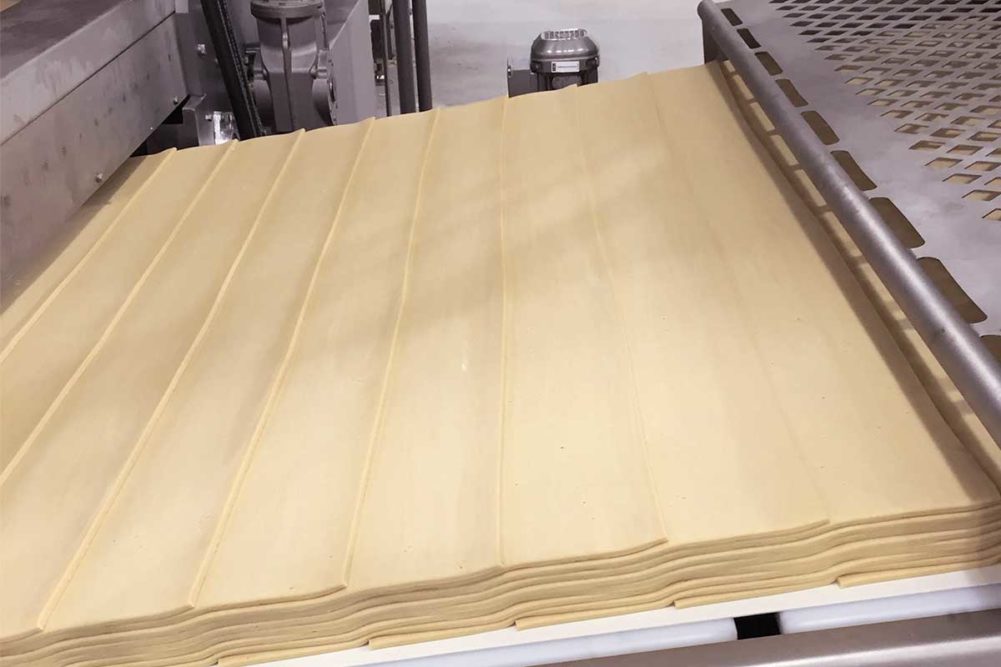Ensuring that sheeting and laminating equipment is working optimally by checking settings and parts and performing regular maintenance allows bakeries to maintain quality and throughput. Stability in the process, well-trained operators and maintaining the correct dough temperature are vital when operating high-capacity sheeting lines.
“At high capacity, minute changes will greatly affect the quality of the final product,” said Marco Vidale, head of demo bakery at Rondo.
He emphasized the importance of the consistency of doughs going into the equipment and added that it’s critical for operators to understand any changes occurring and solve them quickly. The faster the line, the quicker the reaction needs to be.
“Bakers need to guarantee the quality of end product. They must be able to have an overview of the production process and pay attention to the finer details, such as recipe and dough resting times,” Mr. Vidale said. “This helps them to intervene promptly if it is to improve the process.”
Bakers running high-capacity sheeting lines must show a keen attention to detail, Ken Zvoncheck, director, process technology, Reading Bakery Systems, stressed when commenting about cracker lines.
“If the sheet quality suffers, then the post-baked cracker will be substandard as well,” he said. “Maintaining a proper pressure pocket in the three or four roll sheeter, lining up lamination sheets precisely as well as utilizing a correct dough crackdown ratio through reductions are all critical. Further, maintaining the optimum speed differential between the final gauge roll discharge to cutting conveyor as well as the cutting conveyor to die roll will ensure the best shape integrity. Operator training as well as clearly stated process parameters are critical to ensuring this is maintained.”
Bakers also need to check equipment feeding the sheeting lines.
“Sometimes I come across a customer either not aware or having inaccurate information on current mixer speeds,” Mr. Zvoncheck said. “Perhaps an operator or mechanic changed it by accident over time. This can have a significant impact on dough development, so it is important to check these speeds occasionally to ensure consistency.”
Bakers must have equipment that is powerful enough to handle large capacities on sheeting and laminating lines.
“If you have a belt width of 1,650 mm and you have to reduce 10,000 kilograms per hour to an end thickness of 2 mm, you can imagine the force on the mechanical components on the line,” said Maarten van der Coer, sales director, Verhoeven Bakery Equipment Family. “Due to the fast speed of the belt, it is a challenge to control the position of the dough sheet and final product.”
Maintaining the layers of a laminated dough means keeping the dough sheet cool enough so the fat doesn’t melt and leak out.
“When making a laminated dough, it is important to have a controlled environment so the fat can be kept cold and not soften,” said John Giacoio, vice president of sales, Rheon USA. “This makes it easier to add and reduce layers when working with a cold dough sheet. When making the layers, it is important that the layers are consistent to ensure the edges of the final dough sheet are not wavy. A consistent dough sheet reduces the amount of waste.”
Five rollers in Fritsch’s TBP dough sheeter rolls out dough gently, and once the gap between the last two rollers is adjusted, the machine automatically adapts all of the upstream rollers accordingly. The centerpiece of the system is the satellite head and its anti-adhesive coated rollers.
“The satellite head is specially designed to sheet the dough as gently as possible, even at high speeds,” said Matt Zielsdorf, director of sales for Fritsch, a Multivac company. “By using a special plate cooling system in the cooling tunnel, the desired core temperature of the dough is reached very quickly, and we can thus ensure that the layers do not mix and that the dough is cooled evenly without drying out the surface.”
This article is an excerpt from the May 2023 issue of Baking & Snack. To read the entire feature on Sheeting & Laminating, click here.






